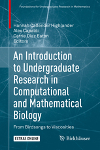- About MAA
- Membership
- MAA Publications
- Periodicals
- Blogs
- MAA Book Series
- MAA Press (an imprint of the AMS)
- MAA Notes
- MAA Reviews
- Mathematical Communication
- Information for Libraries
- Author Resources
- Advertise with MAA
- Meetings
- Competitions
- Programs
- Communities
- MAA Sections
- SIGMAA
- MAA Connect
- Students
- MAA Awards
- Awards Booklets
- Writing Awards
- Teaching Awards
- Service Awards
- Research Awards
- Lecture Awards
- Putnam Competition Individual and Team Winners
- D. E. Shaw Group AMC 8 Awards & Certificates
- Maryam Mirzakhani AMC 10 A Awards & Certificates
- Two Sigma AMC 10 B Awards & Certificates
- Jane Street AMC 12 A Awards & Certificates
- Akamai AMC 12 B Awards & Certificates
- High School Teachers
- News
You are here
An Introduction to Undergraduate Research in Computational and Mathematical Biology

Publisher:
Birkhäuser
Publication Date:
2020
Number of Pages:
481
Format:
Hardcover
Series:
Foundations of Undergraduate Research in Mathematics
Price:
$69.99
ISBN:
978-3-030-33644-8
Category:
Collection
The Basic Library List Committee suggests that undergraduate mathematics libraries consider this book for acquisition.
[Reviewed by , on ]
Frederic Morneau-Guerin
01/23/2021
It is widely acknowledged that providing undergraduate students in mathematics with a genuine research experience contributes positively to academic progress and perseverance as well as fostering the development of skills that will provide a sufficient complement to those generally developed in the regular program. However, identifying and formulating problems that are of interest for the scientific community and are also suitable for examination by students with limited prior knowledge, and implementing such a research program requires an investment in time and effort on the part of professors that may be prohibitive.
The main goal of this collection is to provide undergraduates with a marked interest in computational and mathematical biology with the tools that they need to be able to undertake research without it becoming a burden for the supervisor and a demoralizing experience for the students. To that end, ten groups of researchers who have stood out for the quality of the supervision they have provided to undergraduate students were invited to formulate proposals for research projects located at the intersection of biology and mathematics.
Each of the ten chapters that make up this book starts with an introductory explanation in which the notions and mathematical methods that will be at the core of the described research projects are presented. Great attention has been placed on formulating these introductory explanations so that any student with certain basic knowledge in linear algebra, probability and differential equations can progress smoothly either independently, or with minimal guidance. Those few chapters requiring certain more advanced prerequisites (mainly in high-level programming such as R, Python and MATLAB) explicitly mention that fact on the very first page.
Each chapter contains a certain number of examples, exercises, and more challenging problems. Also included is a detailed list of open problems that could be the subject of a research project that all signs would lead one to believe are within the capabilities of undergraduate students. Each of these chapters is enriched with a complete bibliography. Lastly, in most of the chapters, examples of complete and annotated codes are made available to students (either directly in the text or in an appendix or on a website).
Chapters 1–4 present to the reader various applications of methods for resolving ordinary differential equations to epidemiological or ecological models. Chapters 5–7 address biological networks and classes of computational models for simulating actions and interactions of autonomous agents. The applications addressed include gene regulatory networks and the development of resistance to antibiotics in bacteria. Lastly, chapters 8–10 provide an introduction to other computational methods for which the applications include the study of wave movements produced by a type of cilia lining the bronchial tubes and identifying bird species from analyzing their songs.
This volume also provides a rigorous but accessible presentation of the rudiments of numerous subjects that are generally not in an undergraduate university program, such as hidden Markov models, bifurcation theory, multiresolution analysis and wavelet transformation and convolutive neural networks. This broad range of mathematical fields covered offers students multiple options to undertake research in computational and mathematical biology.
Frederic Morneau-Guerin is a professor in the Department of Education at Universite TELUQ. He holds a Ph.D. in abstract harmonic analysis.
See the publisher's website.
- Log in to post comments




